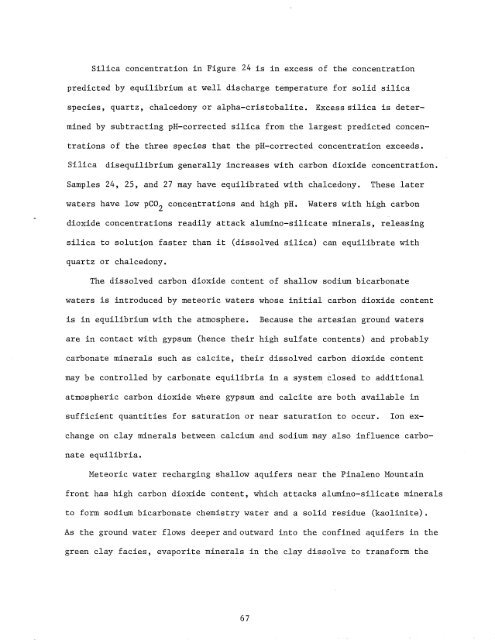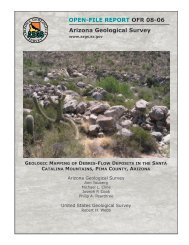geothermal resource potential of the safford-san simon basin, arizona
geothermal resource potential of the safford-san simon basin, arizona
geothermal resource potential of the safford-san simon basin, arizona
You also want an ePaper? Increase the reach of your titles
YUMPU automatically turns print PDFs into web optimized ePapers that Google loves.
Silica concentration in Figure 24 is in excess <strong>of</strong> <strong>the</strong> concentration<br />
predicted by equilibrium at well discharge temperature for solid silica<br />
species, quartz, chalcedony or alpha-cristobalite.<br />
Excess silica is determined<br />
by subtracting pH-corrected silica from <strong>the</strong> largest predicted concentrations<br />
<strong>of</strong> <strong>the</strong> three species that <strong>the</strong> pH-corrected concentration exceeds.<br />
Silica<br />
disequilibrium generally increases with carbon dioxide concentration.<br />
Samples 24, 25, and 27 may have equilibrated with chalcedony.<br />
These later<br />
waters have low pC0 2<br />
concentrations and high pH.<br />
Waters with high carbon<br />
dioxide concentrations readily attack alumino-silicate minerals, releasing<br />
silica to solution faster than it (dissolved silica) can equilibrate with<br />
quartz or chalcedony.<br />
The dissolved carbon dioxide content <strong>of</strong> shallow sodium bicarbonate<br />
waters is introduced by meteoric waters whose initial carbon dioxide content<br />
is in equilibrium with <strong>the</strong> atmosphere.<br />
Because <strong>the</strong> artesian ground waters<br />
are in contact with gypsum (hence <strong>the</strong>ir high sulfate contents) and probably<br />
carbonate minerals such as calcite, <strong>the</strong>ir dissolved carbon dioxide content<br />
may be controlled by carbonate equilibria in a system closed to additional<br />
atmospheric carbon dioxide where gypsum and calcite are both available in<br />
sufficient quantities for saturation or near saturation to occur.<br />
Ion exchange<br />
on clay minerals between calcium and sodium may also influence carbonate<br />
equilibria.<br />
Meteoric water recharging shallow aquifers near <strong>the</strong> Pinaleno Mountain<br />
front has high carbon dioxide content, which attacks alumino-silicate minerals<br />
to form sodium bicarbonate chemistry water and a solid residue (kaolinite).<br />
As <strong>the</strong> ground water flows deeper and outward into <strong>the</strong> confined aquifers in <strong>the</strong><br />
green clay facies, evaporite minerals in <strong>the</strong> clay dissolve to transform <strong>the</strong><br />
67

















